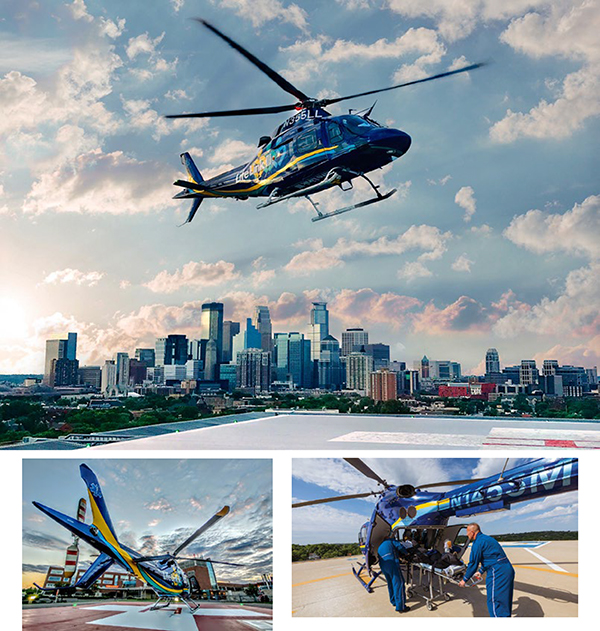by Mina Carlson
MnDOT Office of Aeronautics
Published in Midwest Flyer Magazine February/March 2024 Digital Issue
In my time as a pilot, air medical flying was never in my purview. It wasn’t in alignment with any of my disciplines. Or, so I thought. As a pilot, each flight is mission-centric. Whether for training, traveling, or doing a bit of sunrise appreciation flying, there is a mission. My flights have not been medical-related.
I’ve been fortunate to enjoy the North Shore from the air, flying mostly as a tourist. It wasn’t until 2010 when a close family member hit a deer coming home from Mille Lacs Lake and had to be airlifted from Hwy 169, that I made it a point to better understand the air medical community and its mission. I sincerely and deeply appreciate those who respond to this job daily, the helicopters and infrastructure they use for emergency medical response, and the extensive services available to our state.

How the helicopter came into existence is a bit of a historical marvel. In 400 BC, it was referred to as a Bamboo-copter and was used for amusement and pleasure. Many centuries later, it would be the object of early aeronautical experiments. Nowadays, we know them as helicopters, choppers, copters, heli, and whirlybirds. Today’s helicopters can take-off and land vertically, hover, fly forward, backward, and laterally. They can fly in a congested or isolated area where a fixed-wing aircraft cannot. It’s a multi-purpose machine with much utility; they are used to transport people, cargo, military, construction, firefighting, search and rescue, tourism, medical transport, law enforcement, agriculture, news, and aerial observation, among others. This makes helicopters particularly useful in our sparsely populated rural areas.
Helicopters can be used as air ambulances for emergency medical assistance when an ambulance cannot easily or quickly reach the scene or transport the patient to a medical facility in time. A helicopter will also be used when patients must be transported between medical facilities; air transportation is the most practical method. The use of helicopters as air ambulances is often referred to as “MEDEVAC,” and patients are referred to as being “airlifted” or “medevaced.” Air medical services can travel faster, operate on a broader coverage area than a land ambulance, and reach terrain impractical for a conventional ground ambulance.
To ensure the fastest response possible, Air Traffic Control grants special treatment to air ambulance operations. Much like a ground ambulance using lights and a siren, the special treatment applies only when an air ambulance is actively operating with a patient. When this happens, air ambulance aircraft take the call sign MEDEVAC and receive priority handling in the air and on the ground.
In Minnesota, we have a half dozen air ambulance providers. While the primary mission is to transport trauma, they may also transport blood, organs, and doctors. Minnesota has nearly 5.6 million residents, and with tourism, that can swell to around 6 million people the air medical operators support, 24/7.
The theory of the golden hour suggests that significant trauma patients should be transported as quickly as possible to a specialist trauma center. In our state, over 127 heliport sites can be rapidly accessed. Whether it’s on the border with Canada, the deep woods of the Iron Range and northern Minnesota, or the remote corners of the Iowa/Dakota cornfields, each resident in Minnesota has access to fast-response medical care when needed.
While helipads are essential to fast responses, many considerations must be discussed when planning and maintaining a helipad. Initial conversations may include the city zoning committee, hospital CEOs, volunteer fire departments, facility directors, Minnesota Department of Transportation representatives, civil engineers, and construction consultants.
There is typically a steep learning curve for each individual. Each person becomes immersed in State rules for compliance and the advisory guidelines set forth by the Federal Aviation Administration. It’s similar to learning a new language. And, there isn’t a simple YouTube video to help decipher or Cliff Notes to help work through it.
In many communities, the local fire department typically creates and secures a helipad. In most areas, volunteers in the fire department work to secure the land, train for an incident, manage the licensing criteria, raise funds to sustain the facility, and handle safety on-site during an aviation operation.
When the helipad is located on the hospital grounds, hospital personnel (the ER nurses, grounds/facilities crews, CEOs, and Directors of Operations) will be among the people responding to the helicopter traffic at their facility. They, too, will go through the spool-up of this new operational environment and language, which, for some, is the first time they have heard the term “FOD” (Foreign Object Debris), and what it could mean for the cars parked close to the pad.
The last component of the air medical community is the operators themselves. Operators have both service and business duties that support each flight. In a helicopter, air medical responders provide a higher level of care at the trauma scene and faster transport to a trauma center. They also provide critical care when transporting patients from community hospitals to trauma centers.
Likewise, being an air ambulance business is a tremendous responsibility. There are specific licensing and insurance requirements to abide by, currencies for all flight crew and medical personnel, 24-hour dispatchers, aircraft maintainers, and bases with brick-and-mortar necessities, to list a few executive functions that must be well-operating.
Beyond the helicopter itself, Minnesota has developed an excellent network for the air medical community and those immersed in it. It takes a village to support the incredible air medical mission, and our state is well-prepped and ready to respond to the calling.